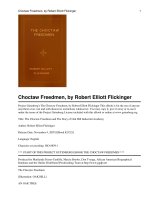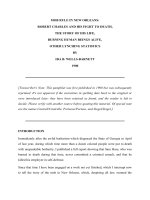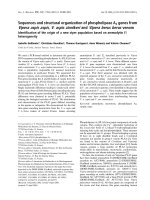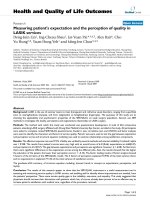Mac Baldrige and the Story of Quality New Mexico (C) Nigel Hey and QNM with cover
Bạn đang xem bản rút gọn của tài liệu. Xem và tải ngay bản đầy đủ của tài liệu tại đây (932.23 KB, 17 trang )
The Story of
Mac Baldrige and
Quality New Mexico
By Nigel Hey
©2015 Nigel Hey & Quality New Mexico
The Story of
Mac Baldrige and
Quality New Mexico
By Nigel Hey
His name was Howard Malcolm
Baldrige, but he insisted that people
called him Mac. The White House
plucked him out of a top corporate job
in New England to be Ronald
Reagan’s first Secretary of Commerce.
He was a Yale graduate (in English)
and had a lifelong passion for the
American West. He loved rodeo life
and enjoyed curling up with a book by
Zane Gray or Louis L’Amour. He was
born in Omaha. He owned a ranch in
New Mexico. And his name is forever
associated with the grand idea that lies
behind Quality New Mexico.
Mac’s sister Letitia (“Tish”), who was
Jackie Kennedy’s social secretary in
the White House, said he was full of
paradoxes. “He likes you to think of
him in jeans low around the hips and
properly scuffed cowboy boots,” she
told
Louise
Sweeney,
staff
correspondent of the Christian Science
Monitor. “He enjoys that. His heart is
in the West, but his body and his mind
are in the East.”
Baldrige died in California in 1987 as
the result of a rodeo accident, leaving
a legacy of successful trade talks with
the Chinese, Indians and Russians –
and a lasting persistence that his office
would be a quality operation; further,
that he expected the rest of America to
follow suit. He was committed to
policies that increase productivity and
customer satisfaction, in particular a
dedication to clear communication.
“Use of the English language.” he
said, “should ideally be styled
somewhere between Hemingway and
Zane Gray.”
Baldrige’s interest in the West was
deepened by reading the books of
Gray, Louis L’Amour and other
Western writers. And his family joined
in. “I loved it,” said his daughter
Molly. “The ranch was a vacation place,
and a way to be involved in the cattle
business and have a foot in the cowboy
world.” His other daughter Megan, a
teacher, was just as enthusiastic: “My
decision to move to Cedar Crest with my
young family in the 1980’s and my
sister’s decision to work for an
agricultural bank in Colorado shortly
after my move was prompted by the
wonderful vacations we had in New
Mexico on the ranch.”
Congress created the Malcolm Baldrige
National Quality Award through Public
Law 100-107 in 1987. On October 17,
1988,
Baldrige
was
presented
posthumously with the Presidential
Tish, Mac, Midge Fall 1983
© 2015 Nigel Hey & Quality New Mexico
1
Medal of Freedom by President Reagan.
He was an inductee of the Professional
Cowboy Hall of Fame, where his
eulogy there makes the points that his
philosophy was simple, and that he
lived it in his business, political, and
rodeo careers: “Success is finding
something you really like to do and
caring about it to do it well. Sticking
your neck out if you’re sure you’re
right, and getting lucky.” 1
The Baldrige Program comes to New
Mexico
“. . . Our histories are intertwined, and it is
both gratifying and humbling to have
witnessed the transformation of this
tremendous organization – from the birth of
an idea, to the personal commitment of so
many who have demonstrated true
leadership in those early years, to
purposeful motion and decisive actions that
led to the formation of Quality New Mexico,
to an enduring commitment and promise of
making a true difference in the health and
welfare of business, education, government,
and healthcare in this great state. . . .”
From “Open Letter to Quality New
Mexico”, Albuquerque, New Mexico,
March 13, 2003
Chris Galvin, Chairman and Chief Executive
Officer, Motorola, Inc.
The Baldrige program’s circuitous
journey to New Mexico started with
Motorola, which after severe public
criticism of its products embarked on a
1
/>
huge quality program under Board
Chairman and CEO Robert (Bob)
Galvin. In the words of a company press
release, “Responding to the rapid rise of
Japanese firms in world markets for
electronics, Motorola’s management
began an almost evangelical crusade for
quality improvement.” 2
In 1981, Motorola launched an
ambitious, successful drive for a tenfold
improvement in the quality of its
products and services. One of its
achievements was development of Six
Sigma, a statistical quality system which
after adoption by General Electric
caused GE Chairman and CEO Jack
Welch to say that: “Six Sigma changed
the DNA of GE.” Six Sigma would
prove to be an important part of
Motorola’s successful bid for the 1988
Malcolm Baldrige National Quality
Award in Manufacturing.
To achieve the quality goal demanded by
Six Sigma, Motorola required that
suppliers start their own Baldrige-based
quality programs. One such supplier was
AT&T, which created an internal
Chairman’s Quality Award based strictly
on Baldrige Criteria, and required each
division to submit a Baldrige application
covering its internal quality program.
AT&T ran Sandia National Laboratories,
based in Albuquerque, New Mexico,
operated for the Department of Energy
under a soon-to-expire management and
operations contract. Before long
2
/>Motorola_Inc.pdf
2
Sandia’s
director
of
Quality
Management, Charles Tapp, was on his
way to briefings at AT&T headquarters
in New Jersey, in effect launching the
lab’s new quality program.
New Mexico’s quality initiative gained
momentum in September, 1991, after
Chris Galvin, Bob’s son and then
Motorola’s Assistant Chief Operating
Officer, made a germinal off the cuff
speech to a group of business leaders at
Las Cruces, N.M., at the invitation of
Sen. Jeff Bingaman. Mac Baldrige had
died four years earlier, and the
Department of Commerce’s Baldrige
National Quality Program had since
been named in his honor. Galvin knew
about quality: it was his company’s main
weapon of defense against the onslaught
of new foreign competitors in the
international electronics markets. The
company, once criticized for poor
quality, had received the national
Baldrige Award. Now he was spreading
the success story.
“I had met [Chris] and his father, Bob,
and had been aware of the Six Sigma
initiative they had developed at
Motorola,” Bingaman told me. “The
larger agenda was to help New Mexico
businesses create and grow jobs. I had
also gotten acquainted with Malcolm
Baldrige during his time as Secretary of
Commerce and had been impressed with
his efforts to promote quality
improvement in U.S. businesses. This
was the period during which U.S.
companies were very focused on the
competition
Japan.” 3
from
Asia,
especially
In short, Galvin’s Las Cruces speech
made a powerful case for quality
initiatives, discussing Motorola’s Six
Sigma quality and the Baldrige Award,
ultimately challenging New Mexico to
be the first to be able to put on its license
plates: “New Mexico = The Quality
State.” 4 A good way to start this journey,
he said, would be to visit Motorola
University in Schaumburg, Illinois, to
learn what Motorola was doing to
promote improved performance in all
parts of his corporation. For many of his
listeners this sounded like an opportunity
too good to miss.
Meanwhile,
Sandia
National
Laboratories was planning to offer its
expertise in quality matters to the state
at large as a public service, and its
unclassified technical expertise as a
service to industry. Sandia Executive
Vice President C. Paul Robinson, who
was Charles’s supervisor, had been
particularly disturbed by Japan’s leap
forward in the automotive market. The
U.S. was not producing what its
longtime customers wanted, he said,
and “We believed America should
wake up.” The management of U.S.
industry also needed streamlining.
“Bureaucracy is like entropy, always
increasing. We want to knock it back,”
he told me. “The quality method is the
only remedy I know that will counter
3
4
Sen. Jeff Bingaman, email message, June 1, 2015
Chris Galvin, email message, May 31, 2015
3
encroaching
bureaucracy.” 5
New
Mexico had similar problems, albeit
on a very much smaller scale.
Robinson’s director of Quality
Management, responsible for the New
Mexico initiative, was a veteran
scientist whose quality expertise ran
from the reliability of microelectronics
circuits to the integrity of metal
castings. Now another fortunate chain
of events took form. Charles Tapp
learned from consultant Faith Ralston
that a man named Jim Buckman was
running a successful state quality
program in Minnesota, using principles
laid down by the Baldrige Program.
Soon Tapp was heading for St. Paul,
where Buckman was at the reins of the
pioneering Minnesota Council for
Quality.
After a day of briefings, Charles thought
it likely that like Minnesota, New
Mexico could prosper through coaching
its companies, schools, and government
agencies to adopt Baldrige principles
that would stimulate the performance
excellence needed to bring about and
sustain business success. Properly done,
the idea would be a winner. The process
would be guided by veteran volunteers
with the help of workbooks and selfassessment aids. Participants would team
with others with like interests and
compete for state awards. With this
process completed, they could set their
sights on the program’s top prize, the
5
Malcolm Baldrige National Quality
Award, “the nation’s only Presidential
award for performance excellence.”
1st Anniversary, July 1994 (Senator Jeff
Bingaman, Joyce Godwin, Governor Bruce
King, Charles Tapp, In the back row: Glenn
Walters, Mike Silva and John Jennings.)
Charles’s Minnesota trip report received
a warm reception at home, and Sandia
would formally adopt the Baldrige
protocols for periodic self-assessment
and improvement in 1994. Soon his
organization was joined by a fellow
Sandia staff member, Julia Gabaldón,
who tackled the state quality program
with enthusiasm.
Paul Robinson later called Charles and
Julia his “ringleaders” in getting the state
quality program into gear.
In January 1992, a group of 30
distinguished New Mexicans, energized
by the Galvin speech, had packed their
bags and were on their way to their day
at Motorola University. Here they would
learn about Motorola quality programs
so that they could later develop their
own their visions for transforming New
Mexico into a “Quality State.” Senators
Pete Domenici and Jeff Bingaman were
C. Paul Robinson, telephone conversation, June 1, 2015
4
there, as were Governor Bruce King,
Joyce Godwin, and a half-dozen other
VIPs from government and the private
sector.
The seminar presentation was a distinct
success, signaling approval for a
statewide quality initiative that was very
likely to bear fruit for New Mexico. It
was considered a solid first step to
developing a comprehensive strategy
that would establish and educate the
state in quality principles and practices.
Soon Bingaman’s staff was putting
together a more detailed blueprint for
bringing the initiative to reality.
“One day Charles Tapp asked if I
wanted to work fulltime on this project,
the state quality initiative, and I said
yes,”
Julia
Gabaldón told me.
“The Senator sent
a letter to Sandia’s
President
Al
Narath asking that
I could be a
loaned executive to facilitate the quality
initiative. I was given the special
assignment on April 1, 1993 – a Sandiaapproved assignment. Charles told me if
anyone at Sandia could do this, I could. I
had zero staff and zero budget. The rest
is history.” 6 From the beginning, Julia
was the dynamic President and CEO of
Quality New Mexico.
6
E-mail message, May 28, 2015
Gabaldón was a good choice. Born to an
Hispanic family in a remote New
Mexico town, she was smart, outgoing,
attractive, and a natural communicator.
By the midsummer of 1993, at a State
Capitol celebration, Quality New
Mexico’s interim board chair, Joyce
Godwin, announced that QNM had
received
$500,000
of
in-kind
contributions including office space in
downtown
Albuquerque,
furniture,
computers, and volunteers from Los
Alamos National Laboratory, Public
Service of New Mexico, and Sunwest
Bank. Plans progressed for the staging of
annual conferences that feature major
speakers from the nationwide Baldrige
community. And Julia, not new to
broadcasting, started a radio program in
2000 that would become the weekly
Performance
Excellence
USA,
aired every Sunday at 7 pm (MST) on
770KKOB.
In 1994, Quality New Mexico took a
major step, stepping into line with other
major participants at the national level –
the Baldrige-based state and local
programs -- by establishing the New
Mexico Quality Awards, which changed
its name to New Mexico Performance
Excellence Awards (NMPEA) in 2012.
Julia has become recognized as a distinct
asset to the national program,
volunteering on the Baldrige Board of
Examiners, Board of Overseers (20042006), its Alliance for Performance
Excellence Board of Directors and the
ASQ Board. New Mexico Business
Weekly honored Julia as a “New Mexico
5
Power Broker” in 2007-2010
“Woman of Influence” in 2010.
and
services. In 2015, a first-level
recognition, Adobe (foundation) was
added to the three-tiered program.
In 1997 QNM’s rise to national stature
was confirmed when retired Gen. Colin
Powell agreed to speak at the annual
conference, drawing more than 2,500
attendees to an event held at the
Albuquerque Convention Center. Other
notable keynote speakers have included
General Norman Schwarkopf, Jim
Collins, Mary Lou Retton, Tim Russert,
Chris Galvin, and Mac’s widow Midge
Baldrige.
Quality New Mexico’s “firsts” among
the national Alliance for Performance
Excellence community of Baldrige
affiliates also include:
•
•
By 2015 Julia, her Board and staff had
recruited a total of 3,461 volunteer
NMPEA examiners, who provided
services estimated at $12.4 million. They
had honored 743 entrants with
recognition and awards that recognize
achievement at three levels of effort –
commitment
(Piñon),
progress
(Roadrunner), and achievement (Zia, for
performance excellence) to establish
NMPEA as NM’s recognition for
performance excellence.
•
•
•
Including the Governor and
Congressional Delegation as
honorary chairs.
Hosting a “Salute to Malcolm
Baldrige” at its 1995 conference.
Producing a weekly Baldrigeoriented radio show.
Maintaining a connection with
Baldrige family (his wife Midge
is a member; daughter Megan
speaks
at
annual
award
ceremonies).
Signing the largest number of
Baldrige Award recipients as
conference speakers.
Recognition is given for organizational
development, not individual products or
6
In 2000 Los Alamos National Bank
became the first New Mexico institution
to receive the Malcolm Baldrige
National Quality Award (for small
business), after receiving the New
Mexico Zia Award for Performance
Excellence the previous year. About 50
bank
employees
travelled
to
Washington, D.C. to see the Baldrige
Award presented by President George
W. Bush.
Megan Baldrige speaking at the Governor’s
Mansion Reception in 2014.
The New Mexico program is one of 35
state quality programs that use the
guidebook
“Baldrige Excellence
Framework” to conduct organizational
assessments. These assessments and
formal feedback help participants to
identify
strengths,
gaps,
and
opportunities for improvement. A
systems approach, it focuses on methods
for
managing
and
leading
all
components of the organization as a
unified whole; managing change; and
dealing with data analytics, data
integrity, and cyber security. It is one of
three related publications that explain
and describe the overall Baldrige
framework: a trio that Gordon Black,
former Chairman and CEO of
Harris/Black International Ltd., said “is
probably the single most influential
document in the modern history of
American business.” 7
7
/>
“No matter what the size of your
organization, involvement in Quality
New Mexico can be of great benefit,”
observed LANB CEO Bill Enloe in the
Albuquerque Journal. “I can attest to the
value of the self-assessment and
feedback available through participation
[in QNM]. The bank has used this
information to identify areas for
improvement and has implemented
many changes, with positive results for
our
customers,
employees
and
8
investors.”
The award brought much-needed
positive attention to a little-known state.
It was evident that, in Charles Tapp’s
words, “having a New Mexico company
win the national award after working
through the Quality New Mexico steps
validates the rigor and discipline of the
New Mexico processes.” 9
8
Bill Enloe, “Quality New Mexico looks too good to be true.”
Albuquerque Journal, March 16, 2000
9
E-mail correspondence, May 28, 2015
7
with
a
rich
history
of
accomplishments.” 11 Today, with two
national awards already to its credit and
its innovative practices, New Mexico is
the state that other members of the
Baldrige Alliance look to as a national
benchmark.
Motorola CEO Chris Galvin spoke at
Quality New Mexico’s first conference
in Carlsbad, N.M. on April 8, 1994. He
returned for its 18th anniversary and its
2011 Learning Summit (pictured above),
when he remarked on the challenge he
had issued for New Mexico “to be a
quality state.” Now he pronounced the
establishment of “a rich and continuing
legacy of motivating, educating and
recognizing New Mexico organizations
for achievements in performance
excellence.”
On Feb. 20, 2012, New Mexico Gov.
Susana Martinez signed an executive
order naming the New Mexico
Performance
Excellence
Awards
Program as the official program “to
recognize New Mexico businesses and
organizations for their adoption, practice
and promotion of quality concepts,
principles and practices.” Gov. Bruce
King signed the executive order that
originally established the awards in
1994.
New Mexico Case Study: New
Quality Journey for VA Center
The outcome could have been different.
“I sensed curiosity and interest, which
could have easily died. But instead, what
followed were concrete steps as well as a
spirit of collaboration between New
Mexico industry and government that
led to the formation of this fine
organization.” 10
In the words of Harry Hertz, Director
Emeritus of the Baldrige Performance
Excellence Program, “QNM is one of
the oldest and strongest state programs
10
Chris Galvin, open letter to Quality New Mexico, March
13, 2003
2009 VP Joe Biden, VACSP’s Thelma Salazar,
Mike Sather, and Commerce Secretary Gary
Locke
11
E-mail correspondence, May 28, 2015
8
The link between Mac Baldrige and New
Mexico is remembered every time
quality enthusiasts hear a talk by Mike
Sather, recently retired director of the
Department
of Veterans
Affairs
Cooperative Studies Program (CSP)
Clinical
Research
Pharmacy
Coordinating Center (CRPCC), located
in Albuquerque. Like Baldrige, Mike
was a government employee and
cowboy – he has a horse ranch on the
edge of the Manzano Mountains south of
Albuquerque. Like Baldrige he sees
something in the cowboy way of life that
links with the state of mind that helps
maintain high quality standards.
The center supports multicenter clinical
trials for the U.S. Department of
Veterans Affairs (VA) and some other
federal agencies. Located in a neat,
closely packaged group of modern
buildings just north of the Albuquerque
Sunport, it became the first VA entity to
become registered in the International
Standards Organization (ISO) 9001 in
2003. Mike considers the VA’s CSP and
investigators to be the customers his
quality program has to please, while
military veterans themselves are the
center’s primary beneficiaries.
When he gives a quality talk Mike
unrolls a 24 by 32 inch poster that is
alive with photos and quotations about
Baldrige, a man who “rode for the
brand.” His VA business card – the
“Director” designator crossed out and
replaced with the handwritten word
“Retired” – features a printed logo that
proudly bears the words “Malcolm
Baldrige National Quality Award 2009
Recipient.” His center was also a
recipient of QNM’s topmost laurels, the
Zia Award for Performance Excellence,
in 2004. “QNM played a significant role
in the Center achieving its National
recognition.”
Originally from Minnesota, Mike moved
to the University of North Dakota for his
degrees in pharmacy, then from 1970 to
1974 developed and taught clinical
pharmacy courses while on call for the
state poison information center. He
began his VA career in 1974 when he
moved to Tampa as supervisor of the
clinical pharmacy section at the VA
Medical Center. In 1976 the VA’s
National Pharmacy Service Director
“voluntold” him to transfer to
Washington, D.C. to develop and head a
new entity (the CRPCC) to support the
CSP with pharmaceutical expertise. The
operation
blossomed,
making
it
necessary to move the entire operation to
Albuquerque in 1977 to acquire much
needed space.
For 35 of his 37 years in Albuquerque,
Mike has been an adjunct professor at
the University of New Mexico’s Health
Science Center College of Pharmacy,
specializing
in
pharmacology,
pharmaceutical law, ethics, and clinical
trials.
Mike hired Stan Johnson to be chief of
the Center’s quality section in the spring
of 1996. A veteran examiner for the New
9
Mexico Quality Awards, Johnson was
thoroughly familiar with the Baldrige
Program, which would be a plus in his
new job. 12
In his job interview, Stan could see that
the Center already had a quality-oriented
organization with a unique culture, and
that Mike was providing strong
leadership. “He had created and shaped a
very unique government agency, and I
wanted to be a part of it.” Still, he and
Mike agreed that “initiating a formal
quality journey would be the right thing
for the Center at that time.” Stan was
aware that his knowledge of the Baldrige
Criteria would help. ”I needed some
pizazz to bring to the position,
something value-added that could help
me establish my credibility as a new
member of the leadership team.”
Stan did not know at the time that all the
centers in the VA’s Cooperative Studies
Program, including the Albuquerque
operation, were under a mandate to
enforce a significant budget cut, to the
extent that some were being threatened
with closure. ”Mike saw that by using
proven business models and criteria such
as ISO 9001 (the International Standards
Organization’s Quality Management
Systems) and the Baldrige Criteria, he
would have a better roadmap for
increasing efficiency and weathering the
budget reduction.”
12
E-mail message, May 29, 2015
Mike remarked wryly that people in
government often are in, or are
anticipating, budget cuts that could do
away with jobs or even entire
organizations. “When you’re in that
situation you have to be good.” That’s
one good reason that, with Stan’s
backing; he committed himself and his
VA colleagues to the Baldrige Program.
“It’s difficult to shoot a winning
racehorse” is one of Mike’s favorite
quotes, illustrating his belief that thirdparty recognition such as Baldrige
Awards and ISO Certification is the best
insurance policy the Center could have.
At first the Center’s staff found it
difficult to accept the Baldrige idea.
“Change is always hard for most folks,
and is nearly impossible for many
federal employees,” said Stan. “But
Mike stayed the course and we
eventually won people over, one by
one.”
“Our quality journey was never
dependent on Mike alone, and it could
never have happened without getting
everyone on board and all rowing in the
same direction. Mike has led the
organization to be self-sufficient and to
have a quality culture spliced directly
into our corporate DNA.”
When he talks about the Baldrige
program Mike likes to refer to the Code
of the West, which by tradition is
followed
by all self-respecting
cowboys. The code is a gentleman’s
agreement on principles of conduct,
10
common-sense when you think about it
but strictly followed. As the western
writer Ramon F. Adams pointed out
long ago, “it was never written into the
statutes, but it was respected
everywhere on the range.” But more
recently Jim Owen, who runs the
Center for Cowboy Ethics and
Leadership in Austin, Texas, put this
situation right. He crystallized the main
points of the cowboy mantra – previous
attempts to do this produced as many
as 40 different principles – and reduced
them to ten crisp dos and don’ts.
CODE OF THE WEST – ETHICS
THE COWBOY WAY
Featured by Jim Owen’s Center for Cowboy
Ethics and Leadership
1.
2.
3.
4.
5.
6.
Live each day with courage
Take pride in your work
Always finish what you start
Do what has to be done
Be tough but fair
When you make a promise keep
it
7. Ride for the brand
8. Talk less say more
9. Remember that some things are
not for sale
10. Know where to draw the line
him with a copy of Owen’s Cowboy
Ethics: What Wall Street Can Learn
from the Code of the West he read it
and was delighted. 13 Owen’s set of the
cowboy’s ten commandments fit his
own view of the way life should be
lived and was a perfect match for the
Baldrige
principles.
Mike
also
employed principles from Don
Bishop’s book The Code of the West –
Then, Now, Forever. 14 Bishop is an
Air Force Veteran who writes about
living life the cowboy way.
“My fascination and passion for the
west and cowboys began early in my
life,” Mike says.
Mike is particularly fond of four of
Owen’s principles – “Live each day
with courage”; “Take pride in your
work;” Be tough but fair;” and “Ride
for the brand.” Two other favorites are
“Rules can always be bent, but
principles cannot” and “Bureaucratic
rules are no substitute for personal
principles.”
Mac Baldrige would have been proud
to know Jim Owen and Don Bishop.
And Mike has become a fan of Owen,
the lean Texan and Bishop, the veteran
Air Force pilot, who answered their
calling to promote the wider
observance of American ethics. “We
developed a set of Ethical Expectations
around our core values: Build enduring
13
Mike had never heard of him, but when
a Montana cowboy friend presented
/>
14
Bishop, Don. The Code of the West – Then, Now, Forever.
Olde West Cedarmill Publishing, Mustang, Oklahoma
11
relationships, respect, adopt a can-do
attitude, seek excellence, and act with
integrity,” says Mike. “We integrated
the Code of the West ‘principles’ into
them, which made the expectations
come alive.”
“I think that the Baldrige Program
enabled us to transform our organization
from being good to a great organization,
one that is very high-performing,” he
added.
Julia Gabaldón remarked that “We feel
tremendous pride that our process has
now prepared two New Mexico
organizations to achieve national
excellence and we have many more in
the pipeline.” And Mike, though retired,
is by no means through. “Now I’m going
help the center start work on a second
Baldrige National Quality Award,” he
promises.
“Entirely possible,” agrees Stan, “and in
fact, most likely.”
Secrets of the Baldrige Program’s
Success
The Baldrige program began in 1987 as
a successful bid to build a federally
managed public-private partnership that
would build upon and complement
existing corporate quality management
plans. It would also work in
collaboration with larger programs that
included the International Organization
for Standardization’s ISO 9000 quality
standards, Lean Manufacturing, Six
Sigma, and W. Edwards Deming’s Total
Quality Management.
The Baldrige program was different. It
was applicable across a wide variety of
different manufacturing, service, and
government organizations. And it
encouraged bottom-up, as well as topdown, communication -- something
that stuck in Mac Baldrige’s mind in
the late 1940s when he worked as part
of a multinational group of manual
workers who would send genuinely
useful suggestions to a management
that coldly ignored them. At the time,
recently discharged from the U.S.
Army, he had decided to start his
civilian life as a blue-collar worker so
that he could learn that part of industry
before he was swept into what he
expected, correctly, would be the
corporate/governmental life suiting a
Yalie.
The Department of Commerce had its
work cut out for it when, in the first days
of Ronald Reagan’s presidency, Mac
moved into the office of the Secretary of
Commerce. The nation’s international
trade situation was in bad shape and its
economic future was uncertain. Better
relations were needed with India, Russia,
and China. Clearly something substantial
had to be done. And Mac would not give
up an enduring passion for improving
managerial quality and his steadfast war
against officialdom’s use of jargon and
bureaucratese. In 1984 his department
12
would publish How Plain English Works
for Business, Twelve Case Studies. 15
The media naturally liked to play on the
near-incongruity represented by a
Secretary of Commerce who spent an
important life as a cowboy and rancher,
and so did their readers. The August 31,
1986 cover of the Chicago Tribune
Magazine featured a stunning action
photo of Mac in his rodeo gear, lariat
swinging over his broad-brimmed hat
as he prepares to rope a calf bolting
from the chute. The headline read:
“Riding Herd on World Trade: It’s
‘High Noon’ for American industry –
and ‘Mac’ Baldrige means business.”
Like other leaders of his time, Baldrige
had been concerned since the late 1970s
that U.S. and European industry was
falling behind Japan and other
competitors. One of his prime goals was
to promote quality management, which
he considered to be a key to national
prosperity and long-term economic
strength. The idea of forming a national
quality management program was
discussed many times in the following
years; legislation to form an organization
for that purpose was proposed. But
nothing happened, even after years of
discussion.
When in the summer of 1987 Business
Week declared, “For U.S. industry, the
message is clear. Get better or get
beaten,” it was as through someone had
15
thrown down a massive gauntlet.16
When the much-liked, highly successful
Secretary of Commerce died two months
later, his colleagues were stunned, from
the President down. With this impetus it
took just three days to create a noble
new idea that was at first called, simply,
the Baldrige program.
“This terrible accident suddenly
created a vehicle that people could
rally around,” said Curt Reimann, who
would become first director of the
Baldrige Program. “There was this
pent-up feeling that something needed
to
be
done
about
national
competitiveness and quality problems.
Those kinds of confluences are very
rare. It was an accident of
circumstances.” 17
The
Senate
Committee on Commerce, Science,
and Transportation promptly renamed
the legislation in Mac’s honor, and it
became one of the laws of the land.
The Baldrige program was to become
known for its emphasis on results and
service and giving participants access
to the insight of specialized
professionals. Meanwhile it focused on
future strategies, customers and the
workforce, and the importance of
sharing information. It is intended to
be integrated into what was already
being done by the organization, or
should be done.
16
“Special Report: The Push for Quality,” Business Week,
June 8, 1987
17
/>e_Program_Began.pdf
/>
13
The Baldrige program is no school for
ninnies. Jim Collins, author and teacher
of leadership skills, puts it this way: “I
see the Baldrige process as a powerful
set of mechanisms for disciplined people
engaged in disciplined thought and
taking disciplined action to create great
organizations that produce exceptional
results.” 18
In more than 35 states across the
country, organizations in six categories –
manufacturing, service, small business,
education, healthcare and nonprofit –
complete annually for the Malcolm
Baldrige National Quality Award
(MBNQA), presented by the President of
the United States. As of 2014, 105
awards had been presented to 99
organizations, including six repeat
winners. The U. S. Department of
Commerce’s National Institute of
Standards and Technology manages the
award as a major part of its services as
manager of the National Baldrige
infrastructure and the ASQ (American
Society for Quality) handles support
activities that include the application
review process, publicity, and outreach.
The Foundation for the Malcolm
Baldrige National Quality Award was
created in 1988 to raise sufficient funds
to establish and manage an endowment;
review
Baldrige
Program
accomplishments; and disburse funds as
needed to NIST to support the Baldrige
Program.
18
/>
As was the case in New Mexico,
organizations frequently participate first
in a state program and then join the
national Baldrige Program. More than
400
quality
professionals
from
throughout the United States serve as
volunteers on the Baldrige Performance
Excellence Program board of examiners,
supporting
and
evaluating
the
performance improvement of Baldrige
participants. A panel of judges appointed
by the Secretary of Commerce selects
candidates for approval by the Secretary
of Commerce.
The basic credo of the Baldrige program
is
that
“investing
in
quality
and performance excellence pays off
in increased
productivity,
satisfied
employees
and
customers,
and
improved results for both customers
and stakeholders.” On a more personal
level, says Julia Gabaldón, it is “a very,
very positive environment of people
working together to help each other
improve.”
Part of the Baldrige way of thinking is
that once the organization is fully
understood weak points can be
recognized and remedies can be
organized and put to work. So
participants start out by analyzing their
organizations’
governance
and
leadership, including ways of making
sure that legal and ethical conduct is
maintained. Then they move to study the
organizational goals and strategies that
are in place to achieve those goals. Once
these steps have been thoroughly
14
covered, the process moves to customer
relations – through listening to their
comments and gathering satisfaction and
dissatisfaction information. Next there is
a study of ways in which the
organization can engage its customers in
order to serve their needs and strengthen
the relationship.
These and other issues are visited
repeatedly during the Baldrige process,
with feedback forms used to help check
progress on organizational goals and
communication technique. Above all,
they are intended to answer the prime
questions Are We Making Progress? and
Are We Making Progress as Leaders?
“One of the things that always struck me
about the Baldrige process is it’s a way
of institutionalizing a culture of
discipline,” author and management
guru Jim Collins told Julia Gabaldón in a
radio interview. Its approach is nothing
like that of managers who lay down the
law and back it up with threats:
“geniuses with a thousand helpers who
personally discipline people.”
“We’re talking about making an entire
cultural ethos where everyone is
engaged in a systematic, methodical,
consistent approach to making things
work better day upon day, week upon
week, year upon year, over a long period
of time.” 19
19
/>04/28/collins-on-baldrige-as-a-smac-recipediscipline-creativity-andparanoia/#.VT_TXxvupg0.email
The Baldrige Sisters – Molly and Megan,
Christmas 2013
Like the Baldrige program, parts of the
Baldrige family have settled firmly in
the West – Megan in Albuquerque’s
North Valley and Molly in Colorado.
When the girls were youngsters the
family would spend two weeks each
summer on the ranch, enabling Mac to
be that cowboy he had wanted to be as a
kid. While his two daughters never
adopted a permanent ranch life, they
refused to give up their peaceful haven
south of Albuquerque. Molly lived there
and worked as a ranch hand for a year
after college. Eventually she moved to
Colorado and started a career in
agricultural mortgage lending. Though it
is hundreds of miles away, the ranch still
stays in her mind. Currently she is
planning to modify its layout so that
stock and pasturage can be managed
more effectively in what have been
many years of drought.
The two sisters are currently putting the
final touches to a book work-titled Mac
15
Baldrige: The Cowboy in Ronald
Reagan’s Cabinet. Centered upon his six
and a half years as Secretary of
Commerce, it will be published by
Taylor Press, an imprint of Rowman and
Littlefield, in November, 2015.
“We didn’t apply [Baldrige] concepts . . . .
to win an award. We did it to win customers.
We did it to grow. We did it to prosper.”
-- Earnest Deavenport, chairman and CEO
of Eastman Chemical Company and 1993
Baldrige Award recipient.
Nigel Hey, a British-born writer and author of
six books, lives in Los Ranchos, part of the
Albuquerque, N.M. area. His most recent book
“Wonderment,” is the memoir of an English boy
who grew up to be a journalist and trade press
writer in London, editor of a Bermuda
newspaper, and finally a journalist and
science writer in the American West.
Learn more about the author and his work at
www.nigelhey.com.
16
© 2015 Nigel Hey & Quality New Mexico









